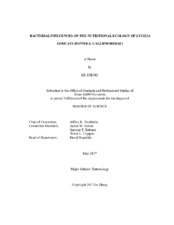| dc.description.abstract | Nutritional ecology provides a novel framework linking biotic factors, such as life-history traits of an animal, to abiotic factors, such as nutrients. Carrion serves as a nutrient-rich and ephemeral environment attracting a host of consumers ranging from microbes to mammals. These diversified consumers accommodate complex ecological relationships. My study primary focuses on bacteria as related to the nutritional ecology of the blow fly, Lucilia sericata (Diptera: Calliphoridae). Four objectives were investigated: 1) to develop a proper sterile diet for examining the bacterial dimension of nutritional ecology framework as related to L. sericata development. 2) to measure the impact of protein: lipid on the life-history traits of L. sericata. 3) to quantify the alternation of life-history traits of L. sericata due to the interactions of exogenous bacteria (Proteus mirabilis and Salmonella) and diet (protein: lipid ratios). 4) investigate the impact of these interactions on associated bacterial communities.
I compared the life-history traits of L. sericata developing on six sterilized diets. Overall, the liver-based diets (decomposed and powdered) resulted in similar L. sericata development as those reared on the fresh beef liver. Larvae reared on blood agar resulted in a significantly (increased 20.56% ± 8.09%) greater pupation rates than those raised on the decomposed and powdered beef liver diets. Pupae from larvae fed the fresh beef liver were significantly larger (6.27 ± 1.01 mg, 4.05 ± 0.94 mg greater, respectively) than those reared on the blood agar diet, decomposed beef liver, and powdered beef liver diets. However, none of these diets were appropriate for my following objectives, because the macronutrients are not adjustable. Therefore, a modified herbivore insect diet was used for the remaining objectives.
Through studies with the sterile herbivore diet, I demonstrated increasing protein: lipid ratio leads to an acceleration of larval development as well as a greater survivorship of L. sericata. Moreover, the introduction of exogenous bacteria altered the responses of L. sericata to the dietary impacts, like the extended duration of each developmental stage. I hypothesized that the alternative in the life-history trait of L. sericata could cause the accumulation of the protein in the diet treatments and the cross-talk with the exogenous bacterial treatment.
Furthermore, to examine the cross-talk with the exogenous bacteria and L. sericata, the 16s rRNA gene amplicon analysis was employed for investigating the bacterial community of L. sericata. According to the result, the diet treatment was unable to alter the bacterial community of L. sericata. Regardless of diet impacts on the development of L. sericata, L. sericata was successfully regulated itself and surrounding bacterial community. However, the regulation mechanism was disrupted by introducing the exogenous bacteria. I also determined the exogenous bacterial treatment did not impact the bacterial community of L. sericata at later development stages, including the pupal and adult. There has yet to be a study investigating the bacterial dimension of nutritional ecology in the carrion system. Therefore, my study contributes to an understudied area of the carrion ecology. | en |


